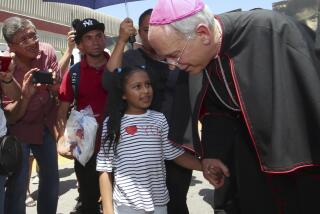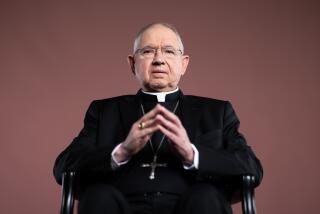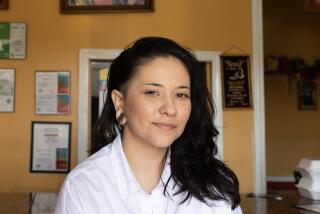Protestants, Sects Woo Latino Immigrants : Catholicism: Many report proselytizing efforts. But report commissioned by a bishopsâ committee says the church should be more concerned about its treatment of newcomers.
Latinos are being wooed away from U.S. Catholic churches by sects and conservative Protestant groups, but proselytizing may be the least of the churchâs problems in ministering to immigrants, according to a study.
Nearly half of the ethnic Roman Catholics surveyed said they had experienced some form of overt proselytism, and 56% of Latinos were told by evangelists from other churches that there is no salvation within the Catholic Church, according to the report released Wednesday.
But the survey findings encouraged the church to admit that although proselytism is occurring, the church should look first at its lack of evangelizing efforts with newcomers.
The report, commissioned by a bishopsâ committee, recommends that the church return to the national and personal parishes that since the 19th Century have given warm welcomes to generations of Irish, Italian, Polish and German Catholics.
âWe need to provide that same kind of community life for new immigrants,â said Sister Elease King, who prepared the report on âProselytism and Evangelization: An Exploratory Study.â
The National Conference of Catholic Bishops discussed the report Thursday at the opening of its spring meeting at the University of Notre Dame. The study done at the Center for Applied Research in the Apostolate at Georgetown University was requested by a bishopsâ committee after 90% of the dioceses responding to a pilot study rated proselytism as a serious problem.
There is no definitive breakdown of ethnic Catholics, but some church officials have estimated that up to a third of the nationâs 58 million Roman Catholics are Latino.
The study involved interviews with 426 ethnic Catholics in 1990 from the dioceses of Brooklyn, Chicago, Galveston-Houston, Los Angeles, Miami, New Orleans, Providence, R.I., and Yakima, Wash.
Dean Hoge, a sociologist at the Catholic University of America in Washington, said the studyâs recommendation that the church concentrate more on tending to the ethnic flock than keeping out proselytizers âis not a bad conclusion.â
âEvangelization, most profitably, starts close to home,â Hoge said.
King said she found that proselytization was going on in every diocese studied.
Fifty-six percent said they have been invited to join another church or denomination, and 51% have been invited more than once.
Among the religious groups most active in appealing to Catholics, Jehovahâs Witnesses extended invitations to 27% of the ethnic parishioners interviewed in the survey. Fourteen percent reported invitations from Baptists and 11% were invited to another church by Pentecostals.
Forty-four percent reported some form of overt proselytism, and 7% said they were offered some form of reward for attending another church. Two percent were threatened by such actions as job loss or no prospects for promotion if they did not switch.
But the most critical problem found was the churchâs lack of cultural sensitivity to many new immigrants, according to the study.
âItâs not the question that other people are trying to steal our people. Itâs the insight weâre not doing enough to serve them as we should,â said Msgr. Nicholas DiMarzio, former director of Migration and Refugee Services at the U.S. Catholic Conference. He served on the reportâs advisory board.
The reportâs recommendations include requiring prospective clergy to be bilingual and bicultural and urging that the church be more sensitive to the popular piety of the newest Catholics.
In taking down crucifixes and statues to provide a more rational worship experience, King said, many churches also have taken away a sense of home and religious identity for immigrants.
In an age when there has been a gradual move toward multicultural churches, perhaps the most striking recommendation in the report is for a âreturn to personal parishes as a viable means of evangelization of new immigrants, refugees and ethnic groups.â
Rising real estate prices and a more mobile population may make it more difficult to return to turn of the century practices, when parishes for different ethnic groups sometimes were only blocks apart.
But church observers said ways need to be found to bring back the same sense of community for new generations of Catholic immigrants from places such as Latin America, Southeast Asia and Korea.
âWhat we need to replicate are the kind of communities that were built around those parishes,â DiMarzio said. âItâs just not as easy as it was. You have to be a little more creative today.â
More to Read
Sign up for Essential California
The most important California stories and recommendations in your inbox every morning.
You may occasionally receive promotional content from the Los Angeles Times.




![[20060326 (LA/A20) -- STATING THE CASE: Marchers organized by unions, religious organizations and immigrants rights groups carry signs and chant in downtown L.A. "People are really upset that all the work they do, everything that they give to this nation, is ignored," said Angelica Salas of the Coalition of Humane Immigrant Rights. -- PHOTOGRAPHER: Photographs by Gina Ferazzi The Los Angeles Times] *** [Ferazzi, Gina -- - 109170.ME.0325.rights.12.GMF- Gina Ferazzi/Los Angeles Times - Thousands of protesters march to city hall in downtown Los Angeles Saturday, March 25, 2006. They are protesting against House-passed HR 4437, an anti-immigration bill that opponents say will criminalize millions of immigrant families and anyone who comes into contact with them.]](https://ca-times.brightspotcdn.com/dims4/default/34f403d/2147483647/strip/true/crop/1983x1322+109+0/resize/840x560!/quality/75/?url=https%3A%2F%2Fcalifornia-times-brightspot.s3.amazonaws.com%2Fzbk%2Fdamlat_images%2FLA%2FLA_PHOTO_ARCHIVE%2FSDOCS%2854%29%2Fkx3lslnc.JPG)





